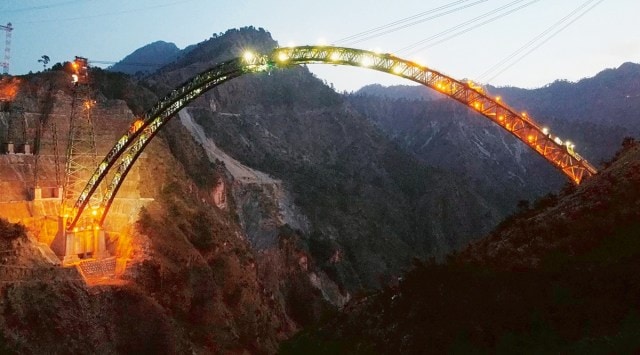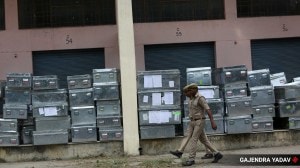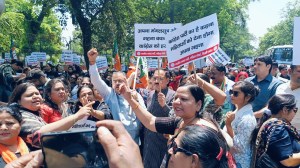- India
- International
Chenab arch to bridge distance between Kashmir, Kanyakumari
The arch, the most difficult part of the Rs 1,400-crore bridge over Chenab, is a major leap towards the completion of the 111-km long-winding stretch from Katra to Banihal. It will symbolise the Kashmir rail link, to be ready for at least a century.
 The world’s highest railway bridge, over river Chenab. (Courtesy: Afcons/Northern Railway)
The world’s highest railway bridge, over river Chenab. (Courtesy: Afcons/Northern Railway)A half-a-kilometre long arch, the defining feature of the world’s highest railway bridge over river Chenab, is set to be completed on Monday. And with this, the biggest civil-engineering challenge faced by any railway project in India in recent history will be over.
The 5.3-metre last piece of metal will be fitted at the highest point on Monday and join the two arms of the arch that currently stretch towards each other from both the banks of the river. This will complete the shape of the arch that will then loom over the treacherous Chenab, flowing some 359 metres below.
The arch, the most difficult part of the Rs 1,400-crore bridge over Chenab, is a major leap towards the completion of the 111 km long-winding stretch from Katra to Banihal. It will symbolise the Kashmir rail link, to be ready for at least a century. In other words, a train from Kanyakumari can reach all the way to Kashmir uninterrupted.
At present, the Kashmir link means a 25-km stretch from Udhampur to Katra, an 18-km stretch from Banihal to Qazigund in the Valley and thereafter the 118-km Qazigund to Baramulla line. All these have been operational for years. The only missing piece in the link is the Katra-Banihal stretch, and the bridge over Chenab was the main engineering hurdle holding up the progress all these years.
The cable crane that will do the job of completing the arch itself measures around 900 meters, and is said to be the longest in the world, made especially for this project.

“Up there, the winds are so rough that we have to stop work several times and resume only when the wind calms down and the weather is right,” said Vijay Sharma, head of the Udhampur–Srinagar–Baramulla Rail Link (USBRL) National Project in Jammu and Kashmir, the arm of Northern Railway that is executing the work.
The moment the winds hit 50-60 km per hour, work stops. And that is how it has been over the past two-and-a-half years it has taken for the arch to be completed.
The Chenab bridge has been mired in controversy since its inception because it is bang in the middle of Seismic Zone IV and nestled in the young, folding Himalayas—making it a tough call for railway engineers. A railway bridge like this, with this kind of geography, has not been made anywhere in the world, according to the Railways. There is also a much smaller Anji bridge before Chenab, but that cable-stayed bridge is nothing when compared to this work, engineers said.
With the arch complete, it is now possible to estimate when the entire project will be complete. So now the much-touted Chenab bridge is scheduled to be completed by this time next year—give or take a few days. “From the erection or structural point of view, the arch was the main, most difficult, item in the whole construction of the bridge. Now, the remaining work, like laying of the deck and the rest will be done over the next 12 months,” he said.
Over the last 2.5 years, engineers have been building the arch with the help of two mammoth cable cranes installed on both banks of the Chenab— the Kauri end and the Bakkal end.
The biggest challenge was that the 550-meter arch, weighing 10,000 metric tons, had to stand only with the support from the two embankments and without any intermediate pier, since the river is 359 meters below and no pier could possibly come at a height like that. From “support to support”, the distance is 467 meters. The whole bridge is going to weigh around 29,000 metric tons. Engineers started work from both embankments simultaneously, starting with the installation of the cranes that would launch the arch.
Each specially designed cable crane, installed at the two banks by Afcons, are around a kilometer long. The two cranes have been working independently and also in synchrony, from each bank and joining pieces of the arch bit by bit.
And for the wielding of the pieces, a national accredited welding lab cum workshop was erected on the construction site, to speed up work—a first for a project in India. Steel pieces are cut with computerised machines, then they are tested as per the standard before being okayed for deployment.
The total length of all the wielding done for the arch, if added, is around 550 km— “almost the distance between Delhi and Jammu,” Sharma said.
Rain, thunderstorms, landslides and even snowfall, have stopped work regularly. They still do. A lot of precision artisanal work is also required because of which workers need to scale the heights with safety gear and perform the various jobs. Along with the engineering challenge, the challenges posed by weather were the biggest hurdle, said Vishwa Murthy, Project Manager of Afcons Infrastructure, which is executing the work for Railways.
“We have been starting work at 5 am every day to continue till late evening, sometimes stretching into extended hours also. After the arch is completed, dismantling the cables, which are now supporting the structure, will take about a month,” he said.
And then there was COVID-19 over the past one year.
Railways, with special assistance from the J&K government, have now got all the 680-odd workers, officers and engineers at the Chenab site vaccinated for free. Every new entrant to the camp is isolated and tested before entry.
By afternoon of Monday, the 5.3 meter metal piece, dangling from one end of a crane, will be slowly placed on the top of the arch. First there will be snug tightening, then a torquing machine will tighten it further as per a pre-set value, and finally the bolt is turned further 90 degrees till it reaches its ultimate strength as per design.
Apr 24: Latest News
- 01
- 02
- 03
- 04
- 05







































